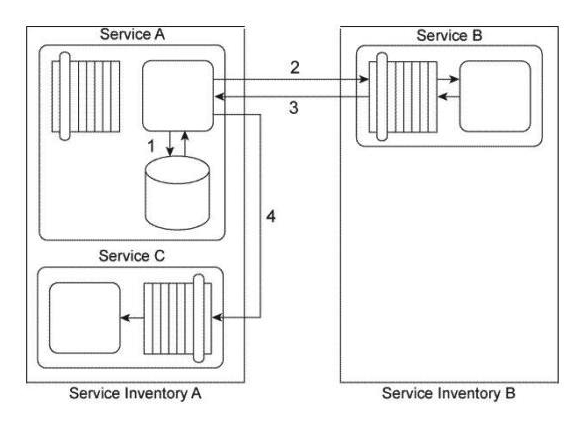Service A is a task service that sends Service B a message (2) requesting that Service B return data back to Service A in a response message (3) . Depending on the response received. Service A may be required to send a message to Service C (4) for which it requires no response. Before it contacts Service B, Service A must first retrieve a list of code values from its own database (1) and then place this data into its own memory. If it turns out that it must send a message to Service C, then Service A must combine the data it receives from Service B with the data from the code value list in order to create the message it sends to Service C. If Service A is not required to invoke Service C, it can complete its task by discarding the code values. Service A and Service C reside in Service Inventory A. Service B resides in Service Inventory B.  You are told that the services in Service Inventory A are all SOAP-based Web services designed to exchange SOAP 1.1 messages and the services in Service Inventory B are SOAP-based Web services designed to exchange SOAP 1.2 messages. Therefore, Service A and Service B cannot currently communicate. Furthermore, you are told that Service B needs to access a shared database in order to retrieve the data required by Service A. The response time of the database can sometimes be lengthy, which would cause Service A to consume too much resources while it is waiting and keeping the code values in memory. How can this service composition architecture be changed to avoid these problems?
You are told that the services in Service Inventory A are all SOAP-based Web services designed to exchange SOAP 1.1 messages and the services in Service Inventory B are SOAP-based Web services designed to exchange SOAP 1.2 messages. Therefore, Service A and Service B cannot currently communicate. Furthermore, you are told that Service B needs to access a shared database in order to retrieve the data required by Service A. The response time of the database can sometimes be lengthy, which would cause Service A to consume too much resources while it is waiting and keeping the code values in memory. How can this service composition architecture be changed to avoid these problems?
Definitions:
Third World
Third World is a term originally used to describe nations not aligned with the capitalist NATO bloc or the communist Warsaw Pact during the Cold War, now often referring to developing countries.
CIA
The CIA, or Central Intelligence Agency, is a civilian foreign intelligence service of the federal government of the United States, tasked with gathering, processing, and analyzing national security information.
Eisenhower Administration
The period of U.S. government from 1953 to 1961 under President Dwight D. Eisenhower, noted for its Cold War tensions and domestic developments.
Third World
A Cold War-era term originally used to describe countries that were neither aligned with NATO (First World) nor the Communist Bloc (Second World), often underdeveloped nations.
Q4: Which is true of Snowflake network policies?
Q8: The highest and best use of the
Q17: Which table stores information about the relationship
Q18: A network engineer is enabling SNMP on
Q34: Your auditors require you to run monthly
Q39: You should always listen attentively to your
Q39: A physical server is having a native
Q42: You need to merge two existing FC
Q60: Which of the following block methods is
Q203: The purest representation of asset/liability dynamics is